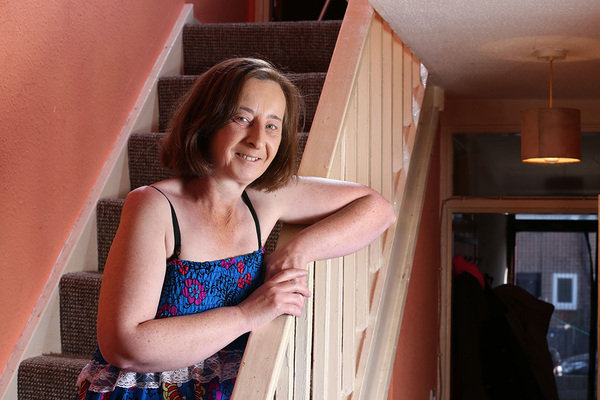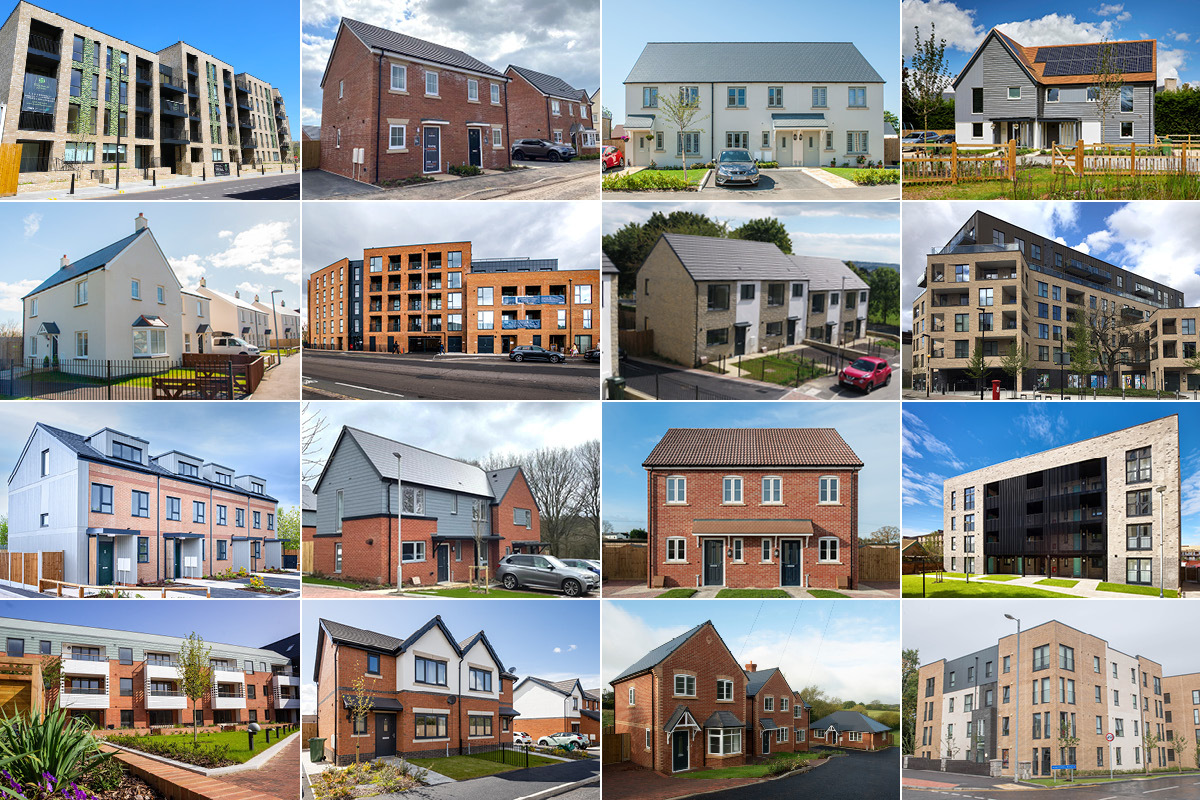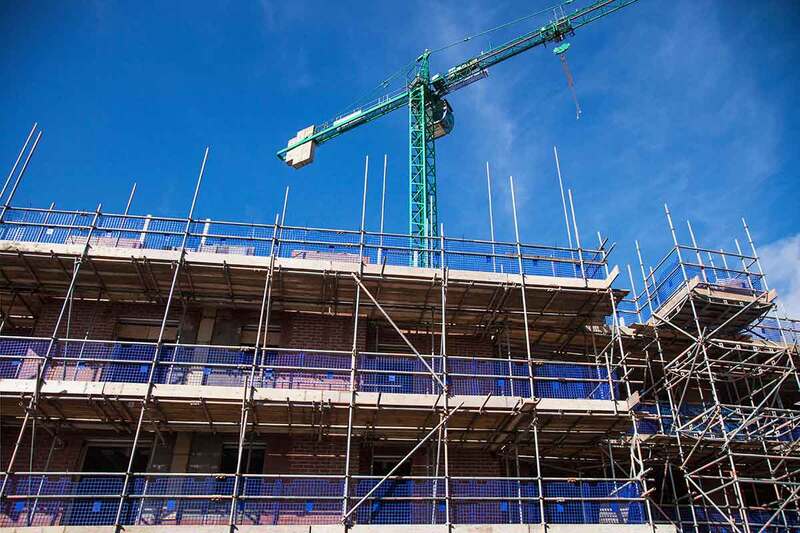Climate change: are housing associations building the wrong homes?
Inside Housing research has found that housing associations are building only a handful of the most energy-efficient homes. Jess McCabe digs into the numbers. Illustration by AJ Higgins
We have a very good idea of what the ‘home of the future’ will be like. Highly insulated, cheap to heat. Perhaps it has a solar panel providing electricity, or a heat pump for heating and hot water. It has a low climate footprint, and residents will be paying much less in energy bills. This is the direction in which regulations across the UK are pushing the sector.
But Inside Housing can reveal that only a handful of housing associations are building these homes of the future. In June, we published our annual survey of housing association development – the Biggest Builders 2021. This year we added some new questions to the 138 associations across the UK, which provided extensive data on how many and what type of homes they were building. We asked for Energy Performance Certificate (EPC) data on the homes they built in the last financial year – in other words, the energy efficiency score of the homes they completed between April 2020 and March 2021. We wanted to know how many the associations completed at the highest rating – Band A.
“This isn’t really an opt in or opt out – the only choice is opt in. You can be forced in kicking and screaming, or you can embrace it and look at the added value it brings”
The 138 housing associations that supplied us data built more than 44,000 homes in 2020/21. But only 651 of the homes achieved Band A. That is less than 1.5% (see box: What is the EPC, and how is it calculated?). The vast majority either built no homes at EPC A, or did not know the information (see pie chart, below). The data is supplied by the development teams of housing associations.
This matters for a couple of reasons. First, living in homes built to minimum standards will be more expensive for the resident in the form of energy bills. And second, homes built to minimum building standards are much more likely to need money spent on them in future – in some cases significant amounts to retrofit them, as regulations change to meet the UK’s net zero national target.
Richard Lupo, managing director of consultancy SHIFT Environment, points out that it will also materially effect how easy it is for landlords to reach zero carbon as organisations, or to hit targets to improve the average EPC rating of their stock.
“The more EPC A homes you’re adding to your stock right now, it brings up the average energy efficiency of the stock that much more, and it’s the average that is the important thing,” he says. “If you’re only adding Bs and you want the average to be mid-range B by 2050, you’ve got to do a hell of a lot more to your existing homes to get them from D to B than from D to C.”
Turning to those housing associations that did complete homes to EPC Band A, we get an interesting picture in terms of who is building those homes and why. The ones building the most are smaller landlords. Newlon – an 8,000 home landlord in London – completed only 149 homes, not enough to make it into our Biggest Builders list. But all 149 of them were EPC A.
Ezinne Ogbonna, business development director, says that the landlord’s board has driven its strategy to build highly energy-efficient homes where this is possible. “We need to make sure that running costs for residents are as low as we can,” she notes. “It’s marginally more expensive [to build], but we find if we are building with partners, the cost
Unsurprisingly, a number of the landlords that did complete EPC A homes are Welsh – the Welsh government has proposed that social housing grant will be given only for homes that are EPC A. Wales has also benefited from several years of funding pilot developments under the Innovative Housing Programme. Pobl, for example, built 47 at EPC Band A last year.
Neil Barber, commercial executive director at the 17,500-home landlord in Newport, says: “We’ve been really fortunate in Wales. Over a number of years, we’ve had a government that has been really committed to affordable housing, and really committed to sustainability. They’ve backed up that commitment with some significant funding.”
Mr Barber estimates the extra cost of getting to EPC Band A at about £12,000 a home – and he notes that this comes at a time when supply chain issues related to Brexit and COVID-19 are also causing materials shortages that are driving up development costs.
“The more EPC A homes you’re adding to your stock right now, it brings up the average energy efficiency of the stock that much more”
The Innovative Housing Programme has run for the past four years, and Pobl has participated in every round of funding. “That has allowed us to trial different options with higher levels of sustainability. We’ve learned quite a bit on the way. And we’ve built up more technical knowledge,” he says.
Yet many landlords building at Band A are in England. Second on the list was Broadacres, a 6,000-home Yorkshire landlord. Of the 136 homes it completed, 112 made the A grade.
Joy Whinnerah, development and investment director at Broadacres, explains that the association’s “standard house type” is now an EPC Band A. Part of what has driven this change for the landlord is its rural location. Many of its developments are located in national parks, and these tend to already come with tougher environmental and design conditions to get planning permission, and the extra cost for EPC A is not that much more.
Which housing associations built homes rated EPC A in 2020/21, and how many did they build?
| Housing association | Number of new homes completed in 2020/21 | How many were built to EPC A? |
| Newlon | 149 | 149 |
| Broadacres | 136 | 112 |
| Pobl | 478 | 47 |
| Rooftop | 50 | 37 |
| A2Dominion | 629 | 27 |
| Vivid | 1,010 | 25 |
| BPHA | 362 | 25 |
| Housing Plus Group | 191 | 25 |
| Clarion | 2,126 | 23 |
| Platform | 909 | 23 |
| Origin | 313 | 20 |
| Tai Tarian | 15 | 15 |
| Bolton at Home | 95 | 14 |
| Wales & West | 287 | 14 |
| Stonewater | 671 | 13 |
| Sovereign | 1,099 | 11 |
| Jigsaw | 525 | 11 |
| Moat | 422 | 11 |
| First Choice Homes Oldham | 84 | 10 |
| The Guinness Partnership | 506 | 9 |
| L&Q | 2,694 | 7 |
| Midland Heart | 350 | 6 |
| Citizen | 503 | 4 |
| Leeds & Yorkshire Housing Association | 32 | 4 |
| The Wrekin Housing Group | 277 | 4 |
| Ocean Housing | 54 | 2 |
| Link | 477 | 2 |
| MHS Homes | 151 | 1 |
“As a rural provider, we’ve got quite a lot of off-gas properties so we’ve had to be ahead of the curve,” Ms Whinnerah says. One in nine of its homes already has an air source heat pump – one of the leading non-fossil fuel heating technologies.
“If we’re already putting air source heat pumps in a property, it makes sense to do those other things [to bring up the energy efficiency of the home]. For us, there’s no point putting in an air source heat pump in a leaky box – that’s what, if you’re not careful, a standard build can be.”
Another factor for Broadacres is ensuring that the housing association is building up its skills ahead of the Future Homes Standard. Ms Whinnerah says that already it is hard to find contractors with the right skill set, for example to install or service a heat pump. Demand is only going to rise, as policy tightens.
“Nothing which is a standard house builder product will hit our sustainability standard”
Like many landlords, Broadacres is moving away from buying homes from private developers in Section 106 deals. Where it still wants to buy up homes in a particular development, Ms Whinnerah says it is now a decision where Broadacres must weigh up that “we know that in three years’ time, we’ve got to come back and spend £20,000 on retrofitting them”.
Sovereign is another of the landlords that have been completing some EPC Band A homes. Tom Titherington, chief investment and development officer, explains that the 59,600-home landlord has recently completed a technical specification that it is applying to all its stock – both existing and new build, called the Homes and Place Standard.
“When we’re doing our own land-led or working with others, we use that as a basic standard. It’s the basis of our own standard house type,” Mr Titherington explains. “Nothing which is a standard house builder product will hit our sustainability standard. It’s built to 2013 Part L building standards. It doesn’t mean you can’t improve it. We can turn around and say if you did this or that [it would be improved]. Some national house builders are really open to that, and some are less so.”
That does not necessarily mean Sovereign would not buy homes on that development, though – but Mr Titherington says it means that the association goes into the development with its “eyes wide open”, knowing if it is going to have to go back to the property to do more work in the future.
What is the EPC, and how is it calculated?
An energy assessor needs to carry out an analysis of the energy and environmental performance of each new home. They use something called the Standard Assessment Procedure (or SAP) to score the home, and depending on that score the home will be given a rating on the A-G scale.
Confusingly, English building regulations do not actually require new homes to hit a specific SAP score or achieve a certain EPC band. This means that the changes coming to English and Welsh building regulations – the Future Homes Standard – cannot be easily translated into homes reaching a certain SAP score or a certain EPC band.
“There’s another calculation that’s about carbon emissions, nothing to do with the cost to the person who’s living there,” notes Richard Lupo of consultancy SHIFT Environment.
The standard in England will from next year require new homes to be 31% lower emissions than current building standards, and a 75% cut by 2025, at which point new homes will also not be able to connect to gas. Scottish proposals would see a 75% cut in emissions by 2030, and all new build homes to be required to use zero carbon heating systems from 2024.
This is particularly significant for social landlords, because some developers will reduce the carbon impact of a particular home by installing an electric heating system, for example, which is lower carbon but more expensive to run for tenants. “If you’ve got low cost you’ve always got low carbon. The reverse isn’t true – you can get low-carbon homes that cost a bundle to operate,” Mr Lupo notes.
The difference in cost for a resident depending on EPC band can be significant. For example, Mr Lupo says that an EPC B home – which is what housing associations are largely building – could see the resident spending about £500 a year on their energy bills.
An EPC A home would be more like £200 a year. The Welsh government’s new mandatory quality standards, which it consulted on last year, call for all new social homes to achieve EPC A. Going back and testing what the energy use is in reality is also crucially important – to make sure that the emissions savings are being achieved, and the costs are reasonable for residents.
“The most important thing is not only designing and building to an EPC A, but checking afterwards that it really is meeting the expected energy [performance],” says Mr Lupo.
He points out that the New Homes Ombudsman could have a part to play in this, although its remit does not at present include environmental or energy performance.
“I think in terms of sustainability scores, EPC and SAP are not particularly good measures and we’re going to move away from those,” he adds. “We’re looking at the construction and the detail of the specification in terms of how the product is going to behave.”
EPCs and the SAP methodology have been widely criticised. The results are based on modelling, which can be inaccurate, and do not have to be tested against actual energy use by the resident.
There is a risk, he says, of just adding technologies and methods to the development process. “You can’t design like that for new build or existing homes, or you get counterproductive or unforeseen consequences, things are too hot, too cold, poorly ventilated. You’ve got to really design it so the home works.”
But not all landlords are building to this standard yet. Inside Housing approached the three biggest builders that delivered no EPC A homes in 2020/21. Metropolitan Thames Valley’s spokesperson tells us: “Last year, all of our completed new build homes obtained an EPC B rating as a minimum, exceeding the government’s target for social housing properties to meet EPC C by 2030. We are working with our contractors and other partners to continually improve the energy efficiency of our homes.”
Number of EPC A homes built by the sector’s top 10 biggest builders
| Housing association | New homes completed in 2020/21 | New homes completed in 2020/21 built to EPC A |
| L&Q | 2,694 | 7 |
| Places for People | 2,186 | n/a |
| Clarion | 2,126 | 23 |
| Notting Hill Genesis | 1,276 | 0 |
| Peabody | 1,176 | n/a |
| Sovereign | 1,099 | 11 |
| Home Group | 1,018 | n/a |
| Vivid | 1,010 | 25 |
| Aster Group | 928 | 0 |
| Metropolitan Thames Valley | 923 | 0 |
| Total | 14,436 | 66 |
A spokesperson for Aster Group says: “Some 85% of our homes already have an energy rating of EPC C or higher, well above the average for the sector, and the 1,000-plus homes we plan to deliver this financial year (2021/22) will all be EPC B. This puts us on track to meet the government’s energy efficiency target for social housing five years ahead of schedule.”
All the landlords Inside Housing spoke to acknowledge that building to the highest standards is a trade-off. Spending more per home is likely to mean fewer homes built overall. But Ms Whinnerah at Broadacres notes: “This isn’t really an opt in or opt out – the only choice is opt in. You can be forced in kicking and screaming, or you can embrace it and look at the added value it brings.”
And to set aside enlightened self-interest for a second, she adds: “It’s absolutely the right thing to do, for the customers and on a global scale.”
Sign up for our development and finance newsletter
Already have an account? Click here to manage your newsletters













